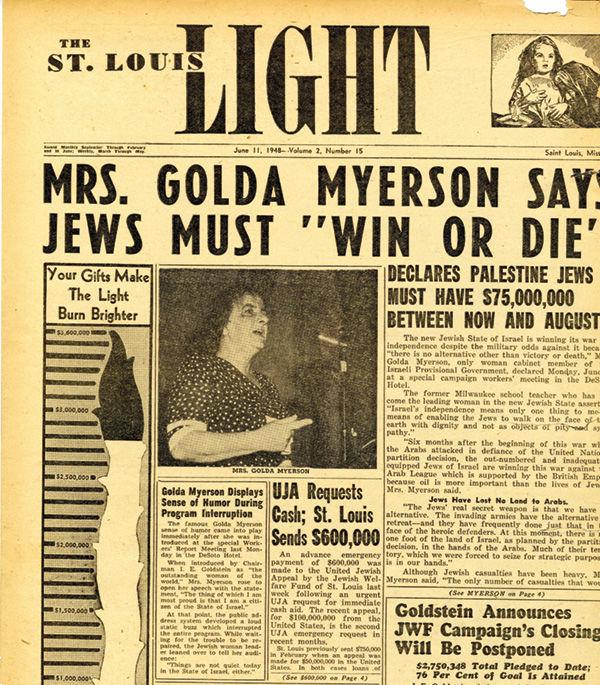When the (real) Golda Meir came to St. Louis
Published October 19, 2016
This story was originally published on October 19, 2016
The one-woman play “Golda’s Balcony,” which is being performed through Oct. 30 at the New Jewish Theatre, features actress Lavonne Byers in a stunning portrayal of the late Israeli Prime Minister Golda Meir, who died in 1978 at the age of 80.
But the real Golda Meir in fact did visit the Jewish community of St. Louis at least twice during her illustrious career, in 1948 and 1949, the first two years of the existence of the Jewish State. At the time, Israel had a Jewish population of about 600,000, compared to a combined Arab nation population of over 100 million.
ADVERTISEMENT
The old St. Louis Light, the predecessor to the present St. Louis Jewish Light, covered both visits. The June 11, 1948 issue of the Light had a Page One headline: “Mrs. Golda Myerson Says Jews Must ‘Win or Die,’” with a sub-headline that read: “Declares Palestine Jews must have $75 million between now and August.”
At the time, Meir had not yet fully changed her name from Goldie Myerson to Golda Meir at then-Israeli Prime Minister David Ben-Gurion’s insistence as. He felt the name Golda Meir would sound “authentically Israeli.”
While in St. Louis, Meir spoke to about 400 Jewish Federation campaign workers at the old DeSoto Hotel. She was described as the only woman in the cabinet of the Israeli Provisional Government and the “leading woman in Israel.”
The Russian-born former Milwaukee school teacher told that 1948 gathering, “Israel’s independence means only one thing to me—a means of enabling Jews to walk on the face of the earth with dignity and not as objects of pity and sympathy.”
ADVERTISEMENT
Meir continued, “Six months after the beginning of this year when the Arabs attacked in defiance of the United Nations’ partition decision, the outnumbered and inadequately equipped Jews of Israel are winning this war against the Arab League, which is supported by the British Empire, since oil is more important than the lives of Jews.”
Holding the audience spellbound with her compelling remarks, Meir added, “The Jews’ real secret weapon is that we have an alternative. The invading armies have the alternative of retreat—and they have frequently done just that in the face of the heroic (Israeli) defenders. At this moment, there is not more than one foot of land of Israel, as planned by the partition decision, in the hands of the Arabs. Much of their territory, which we were forced to seize for strategic reasons, is in our hands.”
During that first Meir visit to St. Louis, Israel’s very existence indeed hung in the balance and its survival was not at all a sure thing. Some 6,000 Israeli Jews—one percent of its population—would be killed in Israel’s War of Independence.
While most Jews at the time took pride in the birth of a new Jewish State after 2,000 years of exile, the American Jewish community was not united in its support of the concept of Zionism. The fact that Meir was so successful in her emergency fund drive is proof of her powerful presence in the United States.
Israel was indeed to prevail in its War of Independence, but its human needs were still critical on June 16 1949, when she addressed a similar meeting at the DeSoto Hotel.
Declaring that the support of St. Louis Jewry, along with other communities, enabled Israel to find peace, Meir, then-Israeli Labor Minister, said she was confident the St. Louis Jewish community would “help us in the reconstruction as it did last year in the war.” She added that Israel would be receiving 250,000 immigrants in 1949, but that 60,000 previously arrived immigrants are still living in refugee camps.
“The only real guarantee of peace in Israel, and therefore the Middle East, is a large population in the Jewish State, which will make it obvious to our neighbors they cannot successfully attack us,” she said.
Meir continued to have close contacts with members of the St. Louis Jewish community throughout her career. The late Isadore E. Millstone, along with other housing industry leaders, worked with the new Jewish State in the development of affordable and sturdy housing to replace the tent settlements of Jewish refugees.
The late Melvin Dubinsky, a longtime St. Louis Jewish community leader and a close friend of Meir, led a mission to Israel in 1972, where he and other local Jewish leaders met with her in Jerusalem. Among those taking part were David Rabinowitz, Louis Susman and Julian L. Meyer, the latter of whom was Jewish Federation president at the time.
I had the privilege of meeting Meir on several occasions in Jerusalem and in New York during visits arranged by the American Jewish Press Association.
In January 1970, our AJPA delegation of 32 editors of Jewish newspapers met Meir at a new conference in Jerusalem. Her head was wreathed with blue smoke from chain-smoking, and her brilliance was obvious in all of her answers.
She said on that occasion and many others, “We can forgive the Arabs for killing our children on the field of battle. We cannot forgive them for forcing our children to kill theirs.”
















